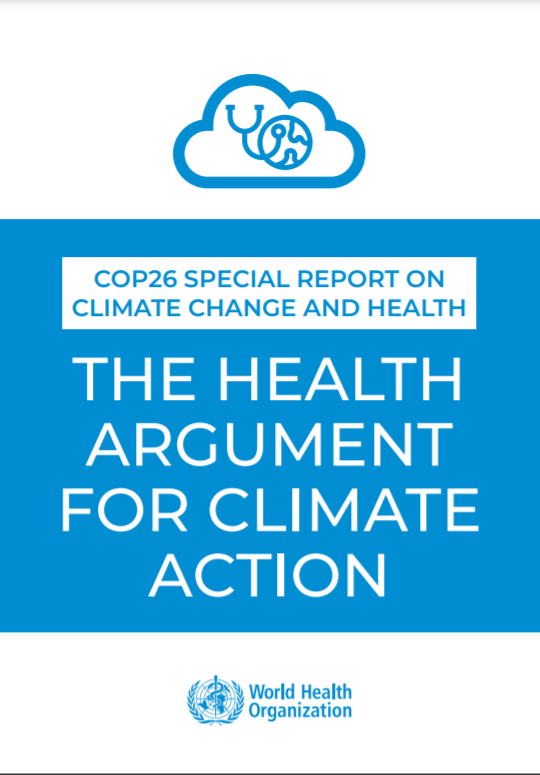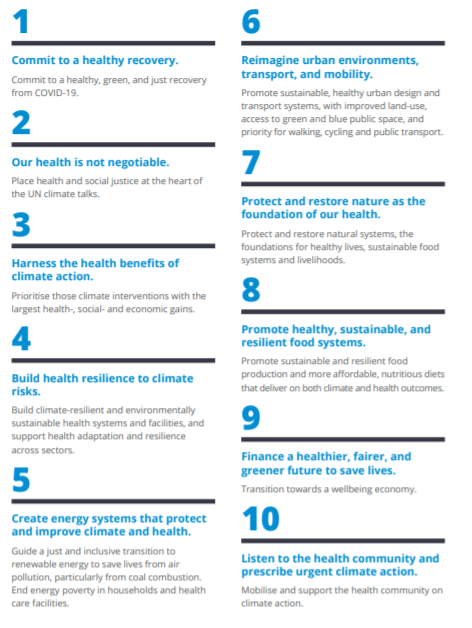Health at COP26.
The Lancet
Talha Burki
October 23, 2021
image: the journal of m health
This is an edition of the Article above by The Lancet, together with the Executive Summary of the WHO Report (World Health Organization) on the 2nd part of this post (COP26 special report on climate change and health: the health argument for climate action. Geneva: World Health Organization; 2021), focusing on the topic of the header of the publication
Edited by The Health Strategist
the blog of Joaquim Cardoso MSc.
World leaders will soon gather in Glasgow for the much hyped climate change conference. Talha Burki looks at the health agenda.
As The Lancet went to press, Glasgow was preparing to host the 26th annual UN climate change conference (COP26). More than 100 world leaders had confirmed that they would attend, although China’s Xi Jinping and India’s Narendra Modi were not among them. US President Joe Biden, who has made environmental health a major focus of his presidency, will be accompanied to Glasgow, UK, by several high-ranking members of his cabinet.
The 2015 conference in Paris (COP21) resulted in a landmark agreement to limit the rise in average worldwide temperatures to “well below” 2·0°C by 2100, and ideally to no more than 1·5°C, compared with pre-industrial levels.
According to a spokesperson, former President Barack Obama will use COP26 to “lay out the important progress made in the 5 years since the Paris Agreement took effect.”
Greta Thunberg, the teenage climate change activist, will also be in Glasgow, although her expectations are low. “Blah, blah, blah. Green economy. Blah blah blah. Net zero by 2050. Blah, blah, blah”, said Thunberg, earlier this year.
“This is all we hear from our so-called leaders. Words that sound great but so far have not led to action. Our hopes and ambitions drown in their empty promises.” Others are more optimistic. “The Glasgow COP26 summit is the turning point for humanity…we are awesome in our power to change things and awesome in our power to save ourselves”, stated UK Prime Minister Boris Johnson, in a speech to the UN General Assembly in September, 2021.
COP26 marks the deadline for countries to reveal their updated nationally determined contributions (NDCs).
These outline how each state intends to reduce its greenhouse gas emissions, in line with the Paris Agreement.
The overarching aim is to reach net zero emissions by 2050.
Countries have mostly established net zero targets, although key nations such as Australia, a huge producer of coal, and India, the world’s third-largest emitter of carbon dioxide, have not yet done so.
“If the NDCs align themselves to the Paris Agreement, then the benefits to health would be pretty substantial”, said Ian Hamilton, professor of energy, environment, and health at University College London, London, UK.
In advance of COP26, WHO released a special report emphasising the need to ensure that health is at the forefront of the climate change agenda. Health has been chosen as a priority area for the conference.
- The WHO report noted that less than 20% of countries had assessed the health co-benefits of their climate change mitigation efforts, and that
- only 13% of NDCs measure how policies and targets affect health.
- It urged countries to incorporate the health perspective within the NDCs.
Doing so would strengthen the case for action and provide a fuller quantification of the benefits.
For example, promoting public transport and creating green spaces in urban centres would
- would not only reduce carbon emissions,
- but would also improve the respiratory and cardiovascular health of city dwellers as well as their mental health.
… the WHO report … urged countries to incorporate the health perspective within the NDCs.
The COP26 health programme argues for the inclusion of health professionals in the advocacy movement.
“Climate change has always been framed as an environmental problem”, said Kristie Ebi, professor at the Center for Health and the Global Environment, at the University of Washington, WA, USA.
“If you look at who attends the COP meetings, there are very few participants from ministries of health. That has to change.”
Matthew Neidell is a professor in the department of health policy and management at Columbia University’s Mailman School of Public Health, NY, USA.
“Health professionals tend to be trusted. It is very valuable to have them join the fight against climate change, especially given that they are on the front line in terms of dealing with the consequences of extreme weather events”, he said.
The COP26 health programme includes proposals for developing low-carbon health systems that are sustainable.
This move will necessitate a baseline assessment of greenhouse gas emissions, including across supply chains, and the identification of those areas which account for the most intensive emissions.
Health care is responsible for around 4·4% of global greenhouse emissions.
The health programme advocates a sector-wide target of net zero by no later than 2050.
“This provides the health sector with an opportunity to demonstrate leadership on emission reduction, contribute to national climate targets, build greater health facility resilience, and directly address the intersection between climate and health”, affirmed the programme document.
Net Zero Pledges
- NHS England has pledged to reach net zero by 2040.
- Several sizeable US health-care providers have made similar commitments.
- India’s Chhattisgarh state is rolling out solar power for all its health-care facilities.
- A handful of countries, including Kenya and Laos, have already submitted formal commitments to the COP26 presidency on the climate resilience and sustainability of their health-care systems.
- Argentina was the first country to commit to estimating its health sector’s contribution to climate change, and to work towards reducing health-related emissions. Its NDC specifically mentions the decarbonisation of the health-care sector.
COP26 attendees are also tasked with building climate-resilient health systems.
- Countries are being asked to draft health national adaptation plans, which take into account the vulnerabilities and adaptive capacities of the sector.
The COVID-19 pandemic has shown how an emergency can strain and, in some cases, even break health systems.
“It is essential to ensure that health systems can continue to deliver essential health functions during extreme events and under climate stress”, states the health programme.
“In order to protect the health of populations from the effects of climate change and avoid widening health inequities, countries must build climate resilient health systems, which consider the current climate and future projections.”
The national adaptation plans and vulnerability and adaptation assessments could be used to leverage funding from climate change programmes as well as help with preparedness for outbreaks of infectious diseases and natural disasters.
The health programme noted that only half of countries have so far established national health and climate change strategies, only half of which report moderate or high levels of implementation.
WHO has asked for stand-alone targets within the NDCs for air pollution and short-lived atmospheric pollutants such as methane. COP26 may well culminate in an eye-catching agreement on methane.
The EU and USA are calling for 30% reduction in methane emissions by 2030, compared with 2020 levels.
As reported in the Lancet Countdown 2021, only 0·3% of climate change adaptation funding is directed at health systems.
“Ministries of health worldwide are looking for a commitment from COP26 to provide them with the human and financial resources required to build climate-resilient and environmentally sustainable health systems”, said Ebi.
“This commitment needs to invest in protecting and promoting population health, and in increasing the resilience of health systems, in the context of a changing climate.
Further, because health systems globally are responsible for nearly 5% of all greenhouse gas emissions, reducing health-care emissions should be a priority for mitigation.”
The human cost
- There are an estimated 7 million deaths every year as a result of air pollution, more than 1 million of which are directly attributable to coal-fired power plants.
- Over the past couple of decades, there has been an increase in heat-related mortality of more than 50%.
- In 2018, almost 300 000 people died because of heat exposure. Older people, migrants, homeless populations, and outdoor labourers are particularly susceptible.
- Working-age adults who are forced to curtail their activities because of heat face the possibility of reduced earnings, which in turn can affect their health and the health of their families.
Warmer temperatures offer opportunities for some vector-borne diseases to spread to previously unaffected regions (although there may also be a reduction in such diseases in places that become too hot or dry for the vector to thrive).
- Heatwaves and droughts imperil food security.
- Wildfires, such as those that struck several countries on different continents this year, pose an immediate threat to safety and fill the air with toxic smoke.
- Flooding is typically accompanied by a host of water-borne diseases and takes a tremendous toll on mental health.
- Migrants who flee places beset by the chaos wrought by climate change can face all kinds of hazards on their outward journey.
- Some potentially devastating consequences of climate change might not be immediately obvious.
Field experiments have shown that the carbon dioxide concentrations expected later this century would reduce the protein and micronutrient content of rice and wheat.
- 2 billion people worldwide have micronutrient deficiencies, and 600–700 million are food insecure.
“We could see hundreds of millions of people being badly affected by the carbon dioxide impact on crops, and that is before we even think about the climate change impact on crop production”, said Ebi.
The WHO special report issued ten recommendations, including one on food. “Global agriculture and food production systems are currently the single largest driver of nature and biodiversity loss, are responsible for about one quarter of global greenhouse gas emissions, and contribute significantly to air pollution”, stated WHO.
“Diseases caused by either food insecurity, or consumption of unhealthy diets, are now the single largest cause of global ill health, and land use change is the single biggest environmental driver of new disease outbreaks.”
The report encouraged countries to shift to healthy, sustainable, and robust food systems.
The ethical case for acting on climate change is incontrovertible. But the economic case is just as strong.
“The public health benefits resulting from ambitious mitigation efforts would far outweigh their cost”, stated the WHO report.
Whether COP26 will lead to meaningful action, or just more blah blah blah, remains to be seen.
But time is running out.
According to the Climate Action Tracker, if the world continues its current trajectory, average temperatures will rise by 2·9°C by 2100.
Identification
DOI: https://doi.org/10.1016/S0140-6736(21)02308-4
Originally published at https://www.thelancet.com
ORIGINAL REPORT

Suggested citation.
COP26 special report on climate change and health: the health argument for climate action. Geneva: World Health Organization; 2021. Licence: CC BY-NC-SA 3.0 IGO.
Executive Summary
The 10 recommendations in the COP26 Special Report on Climate Change and Health propose a set of priority actions from the global health community to governments and policy makers, calling on them to act with urgency on the current climate and health crises.
The recommendations were developed in consultation with over 150 organisations and 400 experts and health professionals.
They are intended to inform governments and other stakeholders ahead of the 26th Conference of the Parties (COP26) of the United Nations Framework Convention on Climate Change (UNFCCC) and to highlight various opportunities for governments to prioritise health and equity in the international climate movement and sustainable development agenda.
Each recommendation comes with a selection of resources and case studies to help inspire and guide policymakers and practitioners in implementing the suggested solutions.
The next few years present a crucial window for governments to integrate health and climate policies in their COVID-19 recovery packages (recommendation 1) and international climate commitments (recommendation 2).
While nearterm pandemic responses will largely set the pace and direction of health and climate goals, ambitious national climate commitments will be crucial to sustain a healthy recovery in the mid- to long-term.
To achieve the goals of the Paris Agreement, health and equity need to be placed at the centre of the United Nations climate negotiations going forward.
The health benefits from climate actions (recommendation 3) are well documented and offer strong arguments for transformative change — and this is true across many priority areas for action:
- adaptation and resilience (recommendation 4),
- the energy transition (recommendation 5),
- clean transport and active mobility (recommendation 6),
- nature (recommendation 7),
- food systems (recommendation 8) and
- finance (recommendation 9).
The health sector and health community are a trusted and influential — but often overlooked — climate actor that can enable transformational change to protect people and planet (recommendation 10)
Recommendations to climate change and Health

Originally published at https://www.who.int
COP26 Special Report on Climate Change and Health
The Health Argument for Climate Action. The 10 recommendations in the COP26 Special Report on Climate Change and Health…www.who.int
Names cited on WHO report
Nigel Topping, COP26 High-Level Climate Action Champion
The development and production of the report were led by Arthur Wyns, Marina Maiero, Alexandra Egorova and Diarmid Campbell-Lendrum from the Department of Environment, Climate Change and Health, WHO.
Some names cited on the Lancet Article
Ian Hamilton, professor of energy, environment, and health at University College London, London, UK.
Kristie Ebi, professor at the Center for Health and the Global Environment, at the University of Washington, WA, USA.
Matthew Neidell is a professor in the department of health policy and management at Columbia University’s Mailman School of Public Health, NY, USA.












